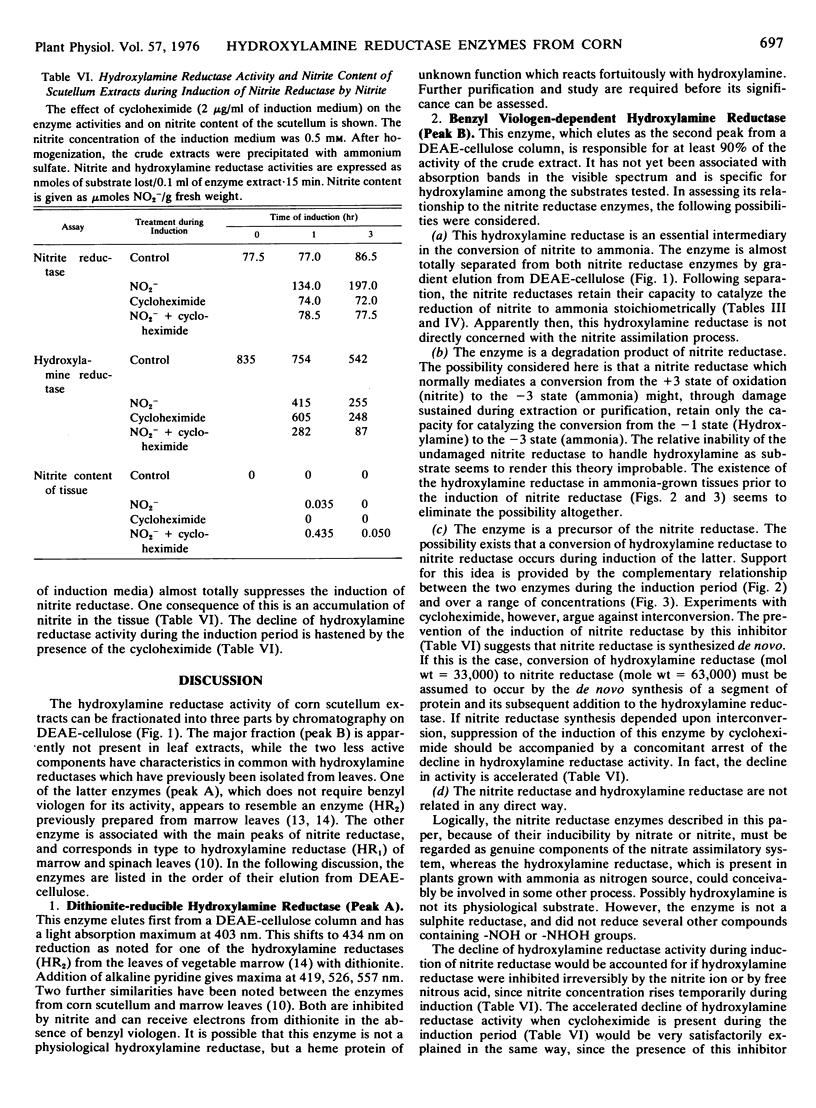Abstract
Three enzymes contribute to the total hydroxylamine reductase activity of corn (Zea mays L.) scutellum extracts. Two of these resemble enzymes previously prepared from leaves, while the third, which accounts for a major part of the activity, appears to have no counterpart in leaf tissue. One of the hydroxylamine reductases found only in small amounts is associated with nitrite reductase and is induced, together with nitrite reductase, by nitrite. The other two enzymes are noninducible by nitrite and can be totally separated from nitrite reductase, which subsequently remains capable of catalyzing the reduction of nitrite to ammonia. Possible causes of the decline of hydroxylamine reductase activity during the induction of nitrite reductase are discussed.
Full text
PDF





Selected References
These references are in PubMed. This may not be the complete list of references from this article.
- Andrews P. The gel-filtration behaviour of proteins related to their molecular weights over a wide range. Biochem J. 1965 Sep;96(3):595–606. doi: 10.1042/bj0960595. [DOI] [PMC free article] [PubMed] [Google Scholar]
- Bourne W. F., Miflin B. J. An ATP dependent reduction of nitrate to ammonia by a cell free particulate system from barley roots. Biochem Biophys Res Commun. 1970 Sep 30;40(6):1305–1310. doi: 10.1016/0006-291x(70)90008-2. [DOI] [PubMed] [Google Scholar]
- Cedrangolo F., Salvatore F., Cimino F., Zappia V. An improved method for determining ammonia formed in enzyme reactions. Enzymologia. 1965 Nov 6;29(3):143–154. [PubMed] [Google Scholar]
- Cárdenas J., Barea J. L., Rivas J., Moreno C. G. Purification and properties of nitrite reductase from spinach leaves. FEBS Lett. 1972 Jun 15;23(2):131–135. doi: 10.1016/0014-5793(72)80322-3. [DOI] [PubMed] [Google Scholar]
- Ferrari T. E., Varner J. E. Intact tissue assay for nitrite reductase in barley aleurone layers. Plant Physiol. 1971 Jun;47(6):790–794. doi: 10.1104/pp.47.6.790. [DOI] [PMC free article] [PubMed] [Google Scholar]
- HAGEMAN R. H., CRESSWELL C. F., HEWITT E. J. Reduction of nitrate, nitrite and hydroxylamine to ammonia by enzymes extracted from higher plants. Nature. 1962 Jan 20;193:247–250. doi: 10.1038/193247a0. [DOI] [PubMed] [Google Scholar]
- Hucklesby D. P., Hewitt E. J. Nitrite and hydroxylamine reduction in higher plants. Fractionation, electron donor and substrate specificity of leaf enzymes, principally from vegetable marrow (Cucurbita pepo L.). Biochem J. 1970 Oct;119(4):615–627. doi: 10.1042/bj1190615. [DOI] [PMC free article] [PubMed] [Google Scholar]
- LOWRY O. H., ROSEBROUGH N. J., FARR A. L., RANDALL R. J. Protein measurement with the Folin phenol reagent. J Biol Chem. 1951 Nov;193(1):265–275. [PubMed] [Google Scholar]
- Russell D. H., Snyder S. H. Amine synthesis in regenerating rat liver: extremely rapid turnover of ornithine decarboxylase. Mol Pharmacol. 1969 May;5(3):253–262. [PubMed] [Google Scholar]
- TAMURA G. STUDIES ON THE SULFITE REDUCING SYSTEM OF HIGHER PLANTS. II. PURIFICATION AND PROPERTIES OF SULFITE REDUCTASE FROM ALLIUM ODORUM. J Biochem. 1965 Feb;57:207–214. doi: 10.1093/oxfordjournals.jbchem.a128078. [DOI] [PubMed] [Google Scholar]


